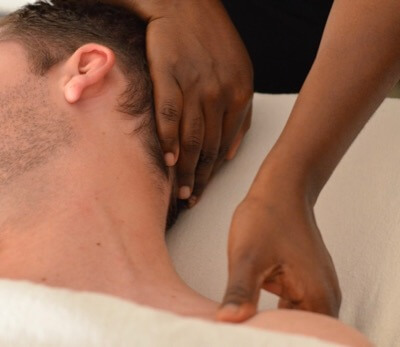- Home
- Western Massage
- Neuromuscular Therapy
As an affiliate for Bookshop, Amazon, and other programs, I may earn a small commission for products purchased through links. This doesn't affect the price you pay. Privacy policy and disclosures.
Search this site:
What is Neuromuscular Therapy?
Neuromuscular therapy (NMT) is a massage-related technique that releases trigger points, muscle adhesions, and fascial (connective tissue) patterns to reduce pain and correct dysfunction.
These problematic areas can form due to trauma, repetitive movements and overuse, exposure to cold or infection, postural misalignment, or chronically tight muscles. While the human body can efficiently and effectively deal with a certain range of stimulation, when it exceeds the central nervous system's limit, changes occur that lead to pain and other dysfunction.

Therapists use specific manual therapy protocols to correct these patterns by releasing tight fascia, trigger points, and stuck muscle, both in areas of pain and in surrounding muscles affected due to biomechanics and compensation for the primary pain.
What's a Trigger Point?
Trigger point massage therapy is probably the best know aspect of neuromuscular therapy.
A trigger point is a localized area of soft tissue dysfunction that refers pain, weakness, or numbness to other locations on your body. The point often feels like a taut or thick band or hard nodule.
For example, trigger points in your abdominal muscles can cause back pain. Trigger points in your upper back muscles can cause headaches. Elbow pain can be caused by a trigger point in your shoulder, forearm muscles, or triceps. Trigger points in the quadriceps can make your knees hurt.
Most trigger points are located in the muscles and fascia. These myofascial trigger points may form in muscle bellies (central trigger points) or in tendons and periosteal attachments (attachment trigger points) and are usually painful when pressed on. Active trigger points cause referred pain and other sensations, tenderness, motor disturbances and autonomic responses in other body tissues. Latent points wait silently in the muscle for a future stress to activate them.
If you have pain that's not being resolved by treating the location of the pain, looking for trigger points is a good idea. One way to release trigger points is static compression. One trigger point massage technique is to apply pressure for 10 seconds – release – apply pressure for 10 more seconds in a pumping action while you breathe deeply. There are also other variations of using pressure to release trigger points.
This technique isn't relaxing and requires that you tell your massage therapist about the pressure and intensity of pain and discomfort. You'll probably need more than one treatment to relieve chronic trigger points.
For in-depth discussion of trigger points and the varying viewpoints on and approaches to them, see Chapter 6, "Trigger Points" in Clinical Application of Neuromuscular Techniques, Volume 1 - The Upper Body, Second Edition, by Leon Chaitow, ND, DO, and Judith Delany, LMT.
What is Neuromuscular Therapy?
Chaitow and Delany's book also explains the differences between European and American versions of NMT. They have similar theoretical foundations but differ subtly in hands-on applications. In American-style neuromuscular therapy, therapists glide a thumb or finger at a medium pace to uncover contracted bands or muscular nodules. In contrast, European-style NMT uses a thumb drag at a slow pace to discover these areas. The two styles also slightly differ in the emphasis on how ischemic compression is used to release trigger points.
A neuromuscular therapist observes, palpates, and assesses a client in many different ways to find problems areas related to the accumulation of past mechanical, chemical, and emotional adaptations (stresses, strains, micro- and macro traumas, deficiencies, toxicities, anxieties, fears, and more) all overlaid on a client's unique characteristics.
A body is in the state it is because of everything that has ever happened to it. The therapist's task is to interpret pieces of evidence from the past and construct a picture of what was, in order to coherently determine why symptoms are as they are in the present and what needs to be done to assist the client toward improvement or recovery.
More Information – What is Neuromuscular Therapy?
The definitive trigger point reference for healthcare practitioners is Travell & Simons' Myofascial Pain and Dysfunction: The Trigger Point Manual, but a more accessible guide is Trigger Point Therapy for Myofascial Pain: The Practice of Informed Touch.
You can also massage your own trigger points. A great reference is The Trigger Point Massage Workbook: Your Self-Treatment Guide for Pain Relief.
For a well-researched (and long!) article about trigger point massage therapy, see The Complete Guide to Trigger Points & Myofascial Pain.
Buy essential oils: Aromatics International or Rocky Mountain Essential Oils.
